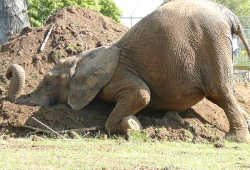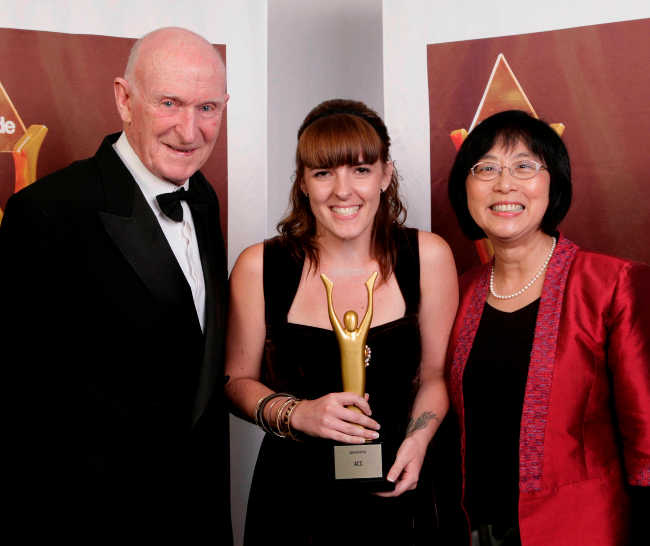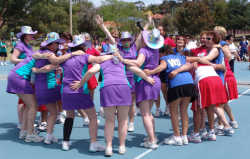Dorothy – 6/3/98
The team in action – Kiwis working with Nepalese to improve schools in remote areas of Nepal. You will probably want to read Part 1 if you have not already…
Fundraising efforts On their return a team of New Zealanders under Barry’s leadership sold seed and gave lectures to raise money for a toilet for the school and a stone wall around the compound. Barry’s wife, Lyn, held the fort at Taunton Gardens to allow Barry to travel on his fundraising tours.
Lincoln Rotary donate a wood burner The Lincoln Rotary Club contributed a really efficient wood burner – a Yunca. A plant auction organised by Barry and Rachel Vogan raised NZ$10,000 and this was used to pay the freight and duty to get the Yunca to Nepal and by helicopter to Khari Khola. It was sent in pieces, most weighing about 35 kg (77lbs), but the firebox weighing 75kg (165lbs). It had to be trekked the rest of the way.
A team of Kiwis returns to Pangkoma A group of eleven New Zealanders from different professions, including plant people and a retired engineer and zoologist, accompanied the Yunca. They were to assemble and install it on arrival.
Nepalese carriers solve a transport problem At Khari Khola a serious problem arose. None of the eleven Kiwis was strong enough to carry the firebox up the 45 degree slope. A young Nepalese man of slight build picked up the firebox and with the help of a friend carried it on his shoulders to Pangkoma.
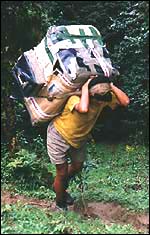 |
| Nepalese carrier with the firebox on his shoulder |
Installation Once there the wood burner was successfully installed in the school. The stainless steel chimney had to be cut with a broken hacksaw blade as the team had no spare blade with them, but they did the job. It will keep the smoke out of the schoolroom and should reduce the number of children suffering from conjunctivitis and respiratory problems caused by the smoky atmosphere.
Nepalese carrier to the rescue again When the team of workers found that they needed extra cement this was a crisis. It had taken them one and a half days to trek from Khari Khola to Pangkoma. They could not wait three days for another bag of cement. One of the Nepalese men ran in the dark on the mountainous track and brought back the cement on his shoulders doing the return trip in fourteen hours.
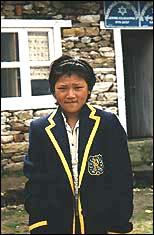 |
| Nepalese student in a Rangi Ruru blazer |
Wonder and joy in the children’s faces The children could hardly believe this miracle that was installed in their school. Their joy over the heater was only equalled by the wonder they felt when given their own pencils and pencil sharpeners. Rangi Ruru School for Girls in Christchurch changed their uniforms and sent many cartons of their previous uniforms to the children at Pangkoma. Singapore Airlines gave the group a freight concession, so each person took a carton of clothing. The children wear these garments with great pride. We can imagine the surprise when Kiwis trekking in the Himalayas meet Nepalese children in an isolated village dressed in New Zealand school uniforms.
Communication between Kiwi and Nepalese children The children of Governors Bay school sent paintings to the children at Pangkoma and the Nepalese children sent their pictures in return.
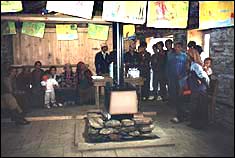 |
| Nepalese people enjoy the warmth of the stove in the schoolroom adorned with the New Zealand children’s paintings. |
The Governors Bay children painted seaside pictures; the Nepalese painted helicopters and eagles – each reflecting what was dominant in their lives.
Firewood New Zealanders shudder at the thought of rhododendrons being chopped down for fire wood. This won’t happen often at Pangkoma in the future. A Nepalese student nurseryman has planted a wood lot which can be coppiced and used for firewood, for desks and for wooden flooring. In the meantime until these trees are ready for cutting the children are asked to bring a piece of dead firewood to school each day to keep the stove burning.
School earns some funds. With the dry floor and the warmth from the stove the building has become an attractive place for trekkers to spend the night. The rent paid by the trekkers will pay for some of the school’s needs.
Another school project under way En route to Pangkoma the work group passed Mera primary school. Here the school was only a bamboo shack offering little protection from the elements. During summer high rivers and many snakes and leeches make it difficult for small children to go to any other school.
These people who had so little had a welcoming party to meet the group and they had built an arch of welcome out of greenery. They presented the group with wreaths of flowers and scarves.
More than US$2000 has been donated to provide a school there and they now have a stone building with a stone roof. A further US$3500 is required to complete the school and surrounding compound.
Betula utilis is a birch tree with bark which is used for paper. Proceeds from the sale of plants of this tree will go towards completing the new Mera primary school.
Visit to New Zealand of Sherpa Ngima Dorji Ngima Dorji is at present visiting New Zealand to observe primary schools, and give addresses on the challenges of improving education facilities in remote parts of Nepal. Barry and his team are hoping that this visit will bring increased future support for this worthwhile project. Ngima is also promoting many trekking options for New Zealanders to enjoy in Nepal.
Anyone interested in information about the education fundraising and the trekking can contact Barry at phone (03) 329-9746.
Read Issue 35 to find out more about Ngima Dorji Sherpa…

